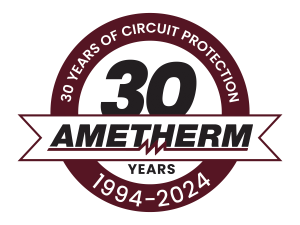Inrush Current Limiters protect electrical equipment from overheating at switch-on due to the surge of input voltage from the power source. Selecting the right Inrush Current Limiter is important. For example, switching power supplies, DC motors, and lighting ballasts can develop extremely high peak inrush current at turn-on unless you implement inrush current protection.
Because inrush current equals the maximum instantaneous surge of incoming current from a power source, it can equate to as much as 2-3 times the steady state current of the attached device. Furthermore, magnetic devices that produce alternating current such as electric motors or transformers can draw as much as 30 times their steady state current at switch-on.
Without protection from inrush current, the only limits on the amount of inrush current drawn are the line impedance and capacitor equivalent series resistance. For details on all our Inrush Current Limiters and more inrush current information and resources, visit our Inrush Current Resources. One would think that because today’s circuitry runs more efficiently maintaining lower impedance; inrush current would not be an issue. Unfortunately, that is not the case. The overall efficiency of low impedance contributes to high inrush current.
How do I Select the Right Inrush Current Limiter for My Application?
Because Inrush Current Limiters can be designed with different characteristics such as the resistance at a specific temperature, it’s necessary to make some calculations based on your application requirements to select the best Inrush Current Limiter for your needs.
How do I Select the Right Inrush Current Limiter for My Application?
Because Inrush Current Limiters can be designed with different characteristics such as the resistance at a specific temperature, it’s necessary to make some calculations based on your application requirements to select the best Inrush Current Limiter for your needs.
At a minimum, you will need to know:
- Maximum Output Power: Based on specific system or design requirements, this is a variable and is relevant to the steady state current of the application.
- Input Voltage: This is the available incoming line voltage to the application in question. For example, 110 or 120 VAC.
You should also know the following information:
- Reset Time: How often the system will be switched on/off during a given timeframe.
- Single Phase or Three Phase: Incoming voltage pulled in from either a single line or three lines.
- Filter or Link Capacitor Value: Value in Micro Farads. Quantifies the magnitude of capacitance.
- Scope Trace of Inrush Current: A snapshot of inrush current at a moment in time.
- Fuse or Circuit Breaker Rating if applicable.
- Inrush Current Rating of Diode Bridge if applicable.



